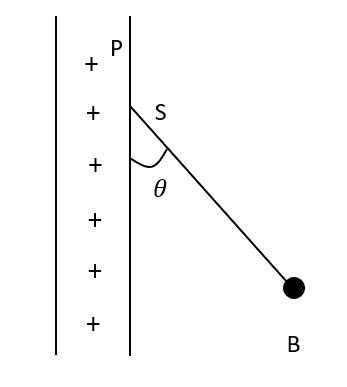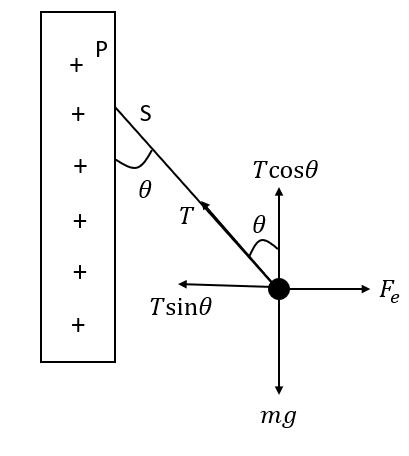
A charged ball B hangs from a silk thread S which makes an angle \[\theta \] with a large charged conducting sheet P as shown in the given figure. The surface charge density \[\sigma \] of the sheet is proportional to:

A. \[\cos \theta \]
B. \[\cot \theta \]
C. \[\sin \theta \]
D. \[\tan \theta \]

Answer
574.2k+ views
Hint: Draw a free body diagram indicating the forces acting on the charged ball. Equate the forces and use the relation between electric field and permittivity of the medium.
Formula used:
\[{F_e} = qE\]
Here, q is the charge of on the ball and E is the electric field.
Complete step by step answer:
The charged ball is placed in a uniform electric field experiences an electric force of magnitude,
\[{F_e} = qE\]
Here, q is the charge of on the ball and E is the electric field.Draw a free body diagram of the forces acting on the charged ball as shown in the figure below,

Balance the forces acting on the charged ball in the vertical direction as follows,
\[T\cos \theta = mg\] ……. (1)
Balance the forces acting on the charged ball in the horizontal direction as follows,
\[T\sin \theta = {F_e}\]
\[ \Rightarrow T\sin \theta = qE\] ……. (2)
Divide equation (2) by equation (1). \[\dfrac{{T\sin \theta }}{{T\cos \theta }} = \dfrac{{qE}}{{mg}}\]
\[ \Rightarrow \tan \theta = \left( {\dfrac{q}{{mg}}} \right)E\] ……. (3)
We know that the electric field is the ratio of surface charge density \[\sigma \]and permittivity of the medium \[\varepsilon \].
\[E = \dfrac{\sigma }{\varepsilon }\]
Substitute \[E = \dfrac{\sigma }{\varepsilon }\] in equation (3).
\[\left( {\dfrac{q}{{mg}}} \right)\dfrac{\sigma }{\varepsilon } = \tan \theta \]
\[ \Rightarrow \sigma = \left( {\dfrac{{\varepsilon mg}}{q}} \right)\tan \theta \]
\[\therefore \sigma \propto \tan \theta \]
So, the correct answer is “Option D”.
Note:
Specify the correct directions of forces acting on the charged ball whether they are along the positive direction of the y-axis or along the negative direction of the y-axis and the same for the x-axis. Here, the electric force should be along the positive direction of the x-axis.
Formula used:
\[{F_e} = qE\]
Here, q is the charge of on the ball and E is the electric field.
Complete step by step answer:
The charged ball is placed in a uniform electric field experiences an electric force of magnitude,
\[{F_e} = qE\]
Here, q is the charge of on the ball and E is the electric field.Draw a free body diagram of the forces acting on the charged ball as shown in the figure below,

Balance the forces acting on the charged ball in the vertical direction as follows,
\[T\cos \theta = mg\] ……. (1)
Balance the forces acting on the charged ball in the horizontal direction as follows,
\[T\sin \theta = {F_e}\]
\[ \Rightarrow T\sin \theta = qE\] ……. (2)
Divide equation (2) by equation (1). \[\dfrac{{T\sin \theta }}{{T\cos \theta }} = \dfrac{{qE}}{{mg}}\]
\[ \Rightarrow \tan \theta = \left( {\dfrac{q}{{mg}}} \right)E\] ……. (3)
We know that the electric field is the ratio of surface charge density \[\sigma \]and permittivity of the medium \[\varepsilon \].
\[E = \dfrac{\sigma }{\varepsilon }\]
Substitute \[E = \dfrac{\sigma }{\varepsilon }\] in equation (3).
\[\left( {\dfrac{q}{{mg}}} \right)\dfrac{\sigma }{\varepsilon } = \tan \theta \]
\[ \Rightarrow \sigma = \left( {\dfrac{{\varepsilon mg}}{q}} \right)\tan \theta \]
\[\therefore \sigma \propto \tan \theta \]
So, the correct answer is “Option D”.
Note:
Specify the correct directions of forces acting on the charged ball whether they are along the positive direction of the y-axis or along the negative direction of the y-axis and the same for the x-axis. Here, the electric force should be along the positive direction of the x-axis.
Recently Updated Pages
Master Class 11 Business Studies: Engaging Questions & Answers for Success

Master Class 11 English: Engaging Questions & Answers for Success

Master Class 11 Computer Science: Engaging Questions & Answers for Success

Master Class 11 Social Science: Engaging Questions & Answers for Success

Master Class 11 Maths: Engaging Questions & Answers for Success

Master Class 11 Biology: Engaging Questions & Answers for Success

Trending doubts
One Metric ton is equal to kg A 10000 B 1000 C 100 class 11 physics CBSE

Explain zero factorial class 11 maths CBSE

An example of chemosynthetic bacteria is A E coli B class 11 biology CBSE

State the laws of reflection of light

What is 1s 2s 2p 3s 3p class 11 chemistry CBSE

Which one of the following is not a method of soil class 11 biology CBSE




